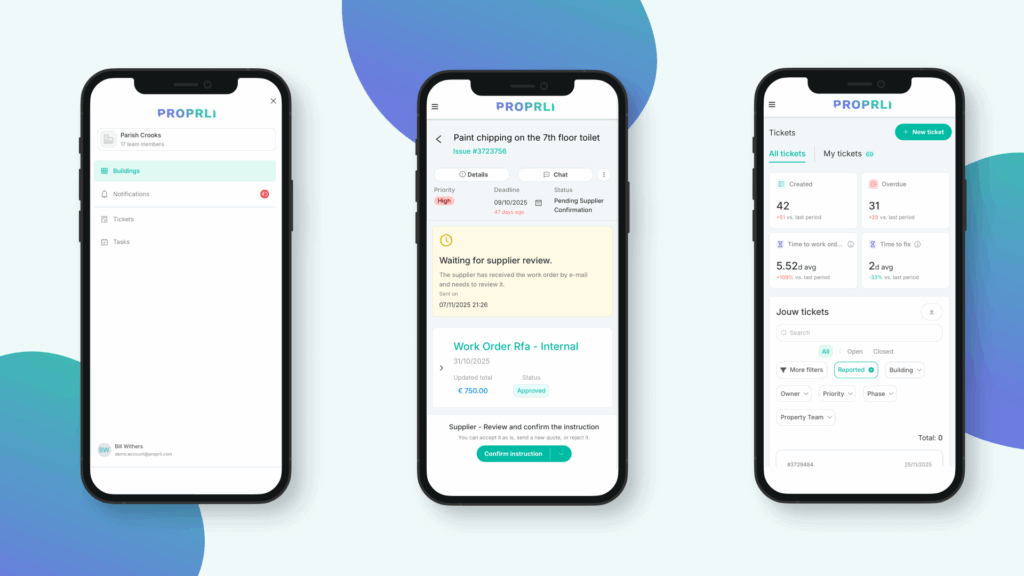Imagine unlocking the full potential of your property management team by integrating collaborative property management solutions into your daily operations. In the fast-paced world of technical real estate maintenance, teamwork in property management isn’t just a buzzword; it’s a strategic imperative that can transform the way your facilities function and flourish. The power of collaboration is no secret; it’s the critical element that can make or break the success of highly complex, interdependent tasks.
You know that technical challenges arise when least expected, and the last thing you need is an obstacle course of communication breakdowns. Embracing teamwork in property management means that your team doesn’t just work together; they excel in synchronized harmony, tackling technical hurdles with a shared sense of purpose and efficiency.
Key Takeaways
- Discover how collaborative property management solutions amplify team efficiency and productivity.
- Learn the significance of fostering a team-oriented culture in handling technical real estate maintenance.
- Understand the immediate benefits of enhanced stakeholder engagement and communication within your team.
- Recognize the long-term advantages of creating a resilient property management ecosystem through collaboration.
- Appreciate the transformative impact of shared success on your property management operations.
The Core Principles of Collaborative Property Management
When you tap into collaborative property management, you’re joining forces with a network of professionals and systems designed to streamline your shared property management experience. This approach not only simplifies the process but also reinforces the bond between you, your tenants, and your maintenance teams, creating a cohesive property management unit. Let’s dive into the fundamental principles that make this form of management stand out.
Understanding Shared Accountability
In the landscape of shared property management, accountability isn’t just a buzzword; it’s the glue that holds everything together. The focus on shared accountability ensures that every team member is on the same page, taking ownership of their responsibilities and understanding their role within the larger framework. This sense of collective responsibility fosters a positive work climate, leading to notable strides in property management.
Unpacking Efficiency Through Teamwork
Efficiency in collaborative landlord services is not an end goal—it’s a continuous journey. By bringing stakeholders together through effective teamwork, you effectively turn time-consuming and disconnected tasks into a streamlined chain of events. This shift towards a unified approach in maintenance tasks and technical troubleshooting not only saves you time but also empowers the teams to deliver top-notch property solutions swiftly.
Synergy in Cross-Functional Teams
Now, let’s harness the power of togetherness. Co-managed properties thrive on the harmony between various skill sets. Cross-functional synergy embodies the real spirit of collaboration, with diverse talents coming together to tackle complex challenges, from routine maintenance to sudden equipment hiccups, ensuring your property runs like a well-oiled machine.
To give you a closer look at how different aspects of collaborative property management come into play, consider this table that contrasts traditional and collaborative models:
| Aspect | Traditional Model | Collaborative Model |
|---|---|---|
| Accountability | Individual based | Team oriented |
| Communication | Siloed approach | Real-time, open channels |
| Problem-solving | Departmental | Integrated cross-functional teams |
| Innovation | Rigid, slow to adapt | Agile and dynamic |
All in all, your journey in collaborative property management will not just contribute to smoother operations but also forge a fortified front against the ever-evolving challenges of the real estate world. Keep these principles as your north star, and watch your co-managed properties reach unparalleled levels of success.
Maximizing Operational Efficiency with Team Collaboration
When you dive into the dynamic world of collaborative operations in real estate, you uncover the sheer power of working together effectively. It’s about breaking down silos and converging on a pathway that streamlines communication and action. The journey towards achieving efficiency in property management starts with a shift in approach—a move towards synergy and collective engagement in solving complex property issues.
A hallmark of successful collaboration in property management is the elimination of redundant communication. This paves the way for a culture where real-time interactions aren’t just hypothetical; they’re the norm. When facility managers can instantly connect with contractors to address an HVAC system’s needs, the result isn’t just a well-maintained unit; it’s an entire operation that runs more smoothly and with less energy waste—a critical consideration in today’s environment.
- Decreasing response times for maintenance and repairs
- Increasing the lifespan of property infrastructure through proactive upkeep
- Enabling cross-functional teams to solve issues swiftly and effectively
It’s crystal clear that collaborative operations in real estate not only spearhead efficiency in property management, but also significantly enhance the quality of service delivered to tenants. They appreciate the prompt response to their concerns, which in turn helps maintain high occupancy rates and customer satisfaction.
So, if you’re looking to elevate your property management game, remember: agility, transparency, and collaborative spirit are your best tools. Embrace them, and you’re on your way to a property portfolio that operates like a well-oiled machine—productive, sustainable, and always ahead of the curve.
Boosting Real Estate Maintenance with Collaborative Strategies
Centralizing communication channels within your property management team is more than a streamlined process—it’s a strategic maneuver that magnifies the efficiency of real estate technical maintenance. By implementing a single, unified system of communication, you’ll see a significant reduction in the mishaps that often arise from scattered messaging. This centralization fosters an environment where information flows freely, ensuring all stakeholders remain fully in the loop, enhancing transparency, and reinforcing accountability.
Centralizing Communication Channels
Centralized communication is a keystone for any property management team. It is the backbone that supports a network of efficient transactions and collaborations among stakeholders. With this unified approach, strategy alignment becomes effortless, and your team can respond to real estate technical maintenance issues with remarkable agility. Imagine a world where every message, every update, and every piece of crucial information is found in one place, accessible to all relevant parties—this is the power of centralizing communication channels.
Fostering a Proactive Maintenance Culture
A proactive maintenance culture is the secret weapon to sustaining property value and ensuring long-term tenant satisfaction. With collaborative strategies leading the charge, early fault detection becomes a norm rather than a rarity. This allows your team to address issues before they escalate into bigger, more costly problems. By promoting a culture where every team member is encouraged and empowered to act ahead of maintenance schedules, you’re guaranteeing a higher standard of property care.
| Strategy | Benefits | Goals |
|---|---|---|
| Unified Communication | Reduced miscommunication, Improved transparency, Streamlined operations | Adopt a central communication system to facilitate property management |
| Proactive Maintenance | Early fault detection, Prevention of costly repairs, Maintained property value | Cultivate a proactive approach to regular inspections and maintenance work |
Empowering Teams through Collaborative Property Management Tools
As you navigate the complex landscape of real estate management, having property management solutions at your fingertips is no longer a luxury—it’s a necessity. Today’s functional property management software is not just about automating the mundane tasks; it is about fostering an environment of collaboration that empowers your team to perform at their highest level.
Imagine a world where task assignment flows seamlessly from one team member to the next, creating a perfect symphony of productivity. Picture getting real-time alerts that enable you to address issues promptly, avoiding setbacks that could impact your operations. It’s all possible with the current generation of property management tools that are designed with your team’s synergy in mind.
Let’s dive deeper into the features that make these tools indispensable:
- Task Assignment: No more chasing emails or playing phone tag. Assign tasks with a click and track their progress in real-time.
- Alerts and Notifications: Stay on top of important updates without being overwhelmed by information.
- Digital Records: Gone are the days of lost paperwork. Access comprehensive records at any time, from anywhere.
- Reporting Tools: Generate reports with ease to keep stakeholders in the loop and make informed decisions quickly.
These tools are more than just features in an app; they are a bridge that connects each team member, fostering a culture of accountability and transparency. Let’s look at some of the benefits that users typically experience:
| Feature | Benefit |
|---|---|
| Automated Task Scheduling | Efficient time management, focused on priority tasks |
| Real-Time Communication | Immediate problem-solving, leading to fewer operational delays |
| Mobile Accessibility | On-the-go management, critical for today’s mobile workforce |
| Centralized Data Storage | One source of truth, minimizing errors and miscommunication |
By integrating these sophisticated solutions into your daily operations, you ensure that your team is equipped to meet the demands of modern property management head-on. The transition to such systems might seem daunting at first, but the long-term gains in productivity and team morale are well worth the effort. Set the stage for success with the right tools, and watch your team’s performance soar.
Enhancing Productivity in Technical Maintenance Tasks
The quest for increased productivity in maintenance tasks for technical properties is an ever-present challenge. Excellence in this domain is pivotal for the successful operation of any facility. Understanding how collaborative approaches and real-time solutions contribute to team efficiency in maintenance helps you stride ahead in the competitive field of technical property solutions.
Prioritizing Real-Time Issue Resolution
Being proactive about issue resolution ensures that downtime in property maintenance is minimized. Embracing platforms that offer real-time alerts and updates gives you the advantage of addressing problems swiftly, preventing them from scaling into costlier repairs. This prompt action not only preserves the integrity of your technical systems but also ensures tenant satisfaction and operational continuity.
Leveraging Diverse Technical Expertise Collaboratively
No single individual holds the key to solving every technical challenge. However, a team that pools together various skills and knowledge can approach maintenance issues with comprehensive strategies. A collaborative work environment thus becomes the hub for innovative solutions, allowing for an impressive range of issues to be tackled efficiently and with expert precision.
| Benefits of Real-Time Issue Resolution | Advantages of Collaborative Expertise |
|---|---|
| Immediate notification of issues | Wide-ranging technical knowledge |
| Quick mobilization of resources | Combined brainstorming power |
| Reduction in system downtime | Comprehensive problem-solving |
| Enhanced tenant satisfaction | Faster, more effective repairs |
| Better allocation of maintenance budget | Shared learning and skill development |
Developing a Resilient Property Management Ecosystem
When you think of resilience in property management, imagine a thriving ecosystem that can withstand the ups and downs of any market. It’s about ensuring that your property management practices are not only robust but also flexible enough to adapt to new challenges. Cultivating such an ecosystem is essential in today’s dynamic economic climate, where adapting property management strategies can determine your success.
You can enhance the resilience of your property management processes by embracing a culture that promotes quick adaptation and efficient problem-solving. A resilient property management team doesn’t just react to changes; it proactively prepares for potential disruptions while maintaining a commitment to service excellence.
- Collaborative Leadership: Foster a leadership style that encourages participation and feedback across all levels of your team.
- Stress Testing Systems: Regularly test your systems and processes against potential scenarios to ensure they can handle unexpected challenges.
- Continual Learning: Encourage a learning environment where team members can grow and stay ahead of industry trends.
Building such an ecosystem isn’t just about having a robust infrastructure; it’s also about people and how they can come together to maintain service standards under pressure. Below is an overview of the key areas you should focus on:
| Focus Area | How It Contributes | Adaptation Strategies |
|---|---|---|
| Communication | Effective communication helps teams respond quickly and cohesively during crises. | Utilize centralized communication platforms to improve transparency and real-time updates. |
| Technology | Innovative technology can automate and streamline processes, reducing the potential for human error. | Integrate property management software that enables effective monitoring and control. |
| Process Management | Well-defined processes ensure consistency in service delivery even when adapting to changes. | Regularly review and update processes to be more adaptable and resilient. |
The key takeaway is to build a property management ecosystem that thrives on adaptability and foresight. It’s about being prepared for the unexpected and having the agility to pivot when necessary. By doing so, you create not just a resilient business, but one that can prosper through the tests of time and change.
Shared Property Management: Creating a Win-Win for All Stakeholders
When you embrace co-managed property benefits, everyone involved in the property’s lifecycle stands to gain significantly. As a stakeholder, whether you’re a property manager, a tenant, or in charge of maintenance, your engagement in property management is crucial for mutual success. The act of coming together in a common effort delivers a potent mix that yields undeniable advantages. Let’s delve into some key benefits that highlight the power of collaboration in property management.
- Cost Efficiency: When tasks and responsibilities are shared, operational costs can be reduced. This collaboration leads to pooling resources and sharing the expense of maintenance and other essential functions.
- Enhanced Communication: With open lines of communication, stakeholders can engage in real-time dialogue, ensuring that everyone is on the same page. This reduces misunderstandings and fosters a more harmonious operating environment.
- Ongoing Engagement: Ongoing stakeholder engagement in property management encourages a sense of ownership and responsibility, which can lead to proactive maintenance and timely responses to issues.
- Streamlined Operations: A joint management approach leads to streamlined operations. By combining expertise and sharing decision-making, processes are optimized for efficiency.
- Innovation and Problem-Solving: When diverse perspectives are welcomed, innovative solutions to property management challenges are more likely to emerge. Collaborative engagement harnesses collective wisdom for enhanced problem-solving.
- Meeting Industry Challenges: Being prepared to meet industry challenges, such as sustainability goals like achieving net-zero emissions, is much more feasible with a unified approach to property management.
Commitment to shared property management not only cultivates a sense of communal achievement but also builds a robust foundation for the property’s success. Leveraging these benefits is not simply about individual gains but about elevating the whole property ecosystem to a level where it operates at its best for everyone’s sake. It’s clear that when stakeholders work together within the property management sphere, the potential for added value is significant, charting a course toward a future that’s positive for all.
The Role of Leadership in Encouraging Team Efficiency
Effective leadership in property management is paramount to the success of any real estate operation. Transformative leaders who champion collaborative leadership in real estate know the tremendous impact they can have on their team’s efficiency and overall productivity. They understand that their actions and leadership style can significantly influence the working dynamics and outcomes of their team’s efforts in maintaining and managing properties.
Adopting ‘Spanning’ Leadership Styles
Adopting a ‘spanning’ leadership style means embracing a role that connects and supports teams across different functions and specializations. Leaders in property management who use this approach are adept at integrating the various disciplines involved in real estate from finance and operations to maintenance and customer service. This inclusive style harnesses the collective strengths of each team member, optimizing the blend of skills and expertise available. The outcome is typically a more agile and responsive team capable of meeting the complex demands of property management.
Promoting Trust and Rapport
At the heart of a successful team lies a foundation of trust and rapport, which are key attributes promoted by collaborative leadership in real estate. When a leader successfully fosters an environment where team members feel valued and understood, it naturally leads to an increase in morale. Trust engendered within teams encourages open communication, a willingness to take calculated risks, and a shared sense of purpose—conditions that are conducive to innovation and problem-solving in the fast-paced world of property management.
In the quest to elevate team efficiency through leadership in property management, it’s crucial for leaders to continue learning and evolving their approach, ensuring that the practices they follow are reflective of the needs and strengths of their team.
Streamlining Property Maintenance through Collaborative Innovations
As you navigate the fast-evolving world of property management, it’s exciting to witness how innovation in real estate maintenance is shaping the future. Cutting-edge collaborative property tech advancements are not just buzzwords; they represent a transformative shift that empowers your teams to work more efficiently together. Here’s how you can leverage these innovations for real-time, impactful results.
Firstly, communication is key. When every second counts, having a way to instantly connect with your team members can make all the difference. Innovations allow for seamless chat features, notification systems, and shared digital workspaces, ensuring no task gets overlooked.
Assigning and tracking tasks have never been simpler, thanks to intuitive platforms that guide your workflow. With a few clicks, you can distribute work orders, monitor progress, and collaborate on solutions without even having to pick up the phone. It’s truly revolutionizing the way property maintenance tasks are managed.
Lastly, the support offered by these innovative solutions for exchanging real-time information enables a proactive approach to maintenance—it’s about preventing issues before they become problems. This proactive stance ensures not only a high operational performance but also guarantees the satisfaction and comfort of your tenants.
Embrace the technology designed to facilitate innovation in real estate maintenance and be part of the community pushing for collaborative property tech advancements. Here is a closer look:
- Instant Messaging & Real-Time Updates
- Task Automation & Simplified Workflows
- Enhanced Issue Tracking Systems
- Data-Driven Decision Support
- User-Friendly Mobile Integration
Equipping your property maintenance team with the latest innovations isn’t just about staying current—it’s about setting the pace for your industry’s future. With a combination of sophisticated tech and a collaborative spirit, you’re not just maintaining properties; you’re elevating them.
Cultivating a Culture of Continuous Improvement in Real Estate Maintenance
Embarking on a journey towards continuous improvement in property management is like planting a garden—it requires patience, care, and most importantly, a consistent nurturing mentality. To flourish in the ever-evolving landscape of real estate maintenance, it’s essential that you promote a culture where every team member feels empowered to contribute to progress and innovation. Here’s how you can foster this essential culture:
- Encourage knowledge sharing: Create opportunities for your team to exchange insights and experiences. This could be through regular meetings, internal newsletters, or a shared digital platform.
- Adopt agile methodologies: Agile practices such as scrum or kanban encourage reflection and rapid adaptation, ideally suited for cultivating real estate maintenance culture.
- Set aside time for innovation: Dedicate resources for your team to explore new ideas without the pressure of immediate ROI. This can lead to breakthroughs that drive long-term efficiency.
Below is a table that breaks down key areas you can focus on to instill this continuous improvement mentality:
| Area of Focus | Objective | Action Steps |
|---|---|---|
| Team Engagement | Strengthen collaborative efforts | Implement regular team-building activities and open forums for discussion. |
| Tenant Satisfaction | Improve service delivery | Collect feedback through surveys and direct communication, and act on it proactively. |
| Professional Growth | Enhance individual and team capabilities | Offer training opportunities and clear pathways for career development. |
| Process Optimization | Streamline maintenance protocols | Analyze current workflows and identify areas for process automation or elimination of waste. |
By committing to these practices, you lay the groundwork for continuous improvement in property management, ensuring your operations remain adaptable and efficient. Remember, cultivating a real estate maintenance culture is a dynamic process. It requires ongoing attention and commitment to achieve and maintain excellence in your property management endeavors.
Conclusion
In the ever-evolving landscape of real estate, collaborative property management success stands out as a pillar for achieving optimal real estate maintenance. You’ve seen that by establishing shared accountability, enhancing communication, and embracing collaborative tools, you can significantly elevate the efficiency and resilience of your property management teams. This approach doesn’t just offer a one-time benefit; it paves the way for sustained excellence and adaptability in the face of diverse market challenges.
Your understanding that strong synergy among team members forms the bedrock of a prosperous property operation has been reinforced. It’s clear that when you work towards unified goals, leveraging each other’s strengths, the entire property management structure becomes more robust, ensuring that maintenance is not only preventative but also innovative in its stride. Hence, a well-oiled collaborative environment propels your property management capabilities to new heights, delivering services that tenants appreciate and rely on.
The insights provided throughout succinctly encapsulate the essence of collaborative property management. They are your guidepost for nurturing a culture where every stakeholder wins—framing the future of property management on a foundation of shared success. Remember, the power to optimize every facet of your real estate maintenance practices resides in the collective efforts of your team and the intelligent application of proven collaborative strategies.
FAQ
What is collaborative property management?
Collaborative property management is a strategic approach where teams work together to enhance efficiency, communication, and productivity in managing and maintaining real estate assets. It emphasizes shared responsibility, open communication, and leveraging collective skills for better technical real estate maintenance.
How does shared accountability improve property management?
Shared accountability in property management ensures that all team members have a joint responsibility for the upkeep and success of the properties they manage. This collective sense of responsibility fosters psychological wellbeing, leading to better performance, increased stakeholder engagement, and a sense of shared success.
In what ways does teamwork increase efficiency in property management?
Teamwork in property management increases efficiency by allowing for cross-functional collaboration, which enables different skill sets to work together in solving problems. It reduces time wasted on unproductive meetings, streamlines communication, and facilitates quick resolution of technical issues.
How can communication be centralized in property management?
Communication can be centralized through the use of centralized communication channels such as collaborative software platforms. These platforms provide a shared space for team members to communicate in real-time, share updates, and manage tasks effectively, avoiding miscommunication and enhancing operational transparency.
What are some collaborative strategies for proactive property maintenance?
Collaborative strategies for proactive property maintenance include regular team check-ins, shared maintenance calendars, digital task management, and real-time alert systems. These strategies ensure early detection of faults and facilitate quick response to maintenance needs, ultimately preventing extensive damage and saving costs.
How do collaborative property management tools empower teams?
Collaborative property management tools empower teams by offering features such as task assignment, real-time alerts, digital records, and communication capabilities that enhance workflow and ensure all members are on the same page regarding property maintenance activities.
What is the benefit of prioritizing real-time issue resolution in maintenance tasks?
Prioritizing real-time issue resolution ensures that maintenance issues are dealt with promptly, reducing downtime, and avoiding potential escalations. This real-time approach increases productivity and helps maintain the functional integrity of the property.
How do collaborative efforts contribute to technical expertise in maintenance?
Collaborative efforts bring together the varied technical expertise of individual team members, allowing for more comprehensive problem-solving. This approach enhances the overall quality of maintenance and ensures that complex technical issues are efficiently addressed.
What makes a property management ecosystem resilient?
A resilient property management ecosystem is one that is well-equipped to handle disruptions, whether they are economic, environmental, or technological. This includes having flexible processes, strong collaborative practices, and a proactive approach to property maintenance and management.
How does collaborative property management create a win-win for stakeholders?
Collaborative property management creates a win-win for stakeholders by improving operations, reducing costs, and enhancing service levels. This collective approach results in better maintained properties, satisfied tenants, and a more engaged and effective management team.
What is the role of leadership in collaborative property management?
Leadership in collaborative property management involves adopting inclusive and transparent leadership styles that foster trust, promote cross-functional communication, and leverage the diverse talents of team members to improve decision-making and innovation in property maintenance.
How are property maintenance tasks streamlined through collaborative innovations?
Collaborative innovations streamline property maintenance tasks by offering real-time data exchange, simplifying the coordination of tasks, and enabling seamless communication among team members, all of which contribute to a more efficient and effective maintenance process.
Why is continuous improvement important in real estate maintenance?
Continuous improvement is essential in real estate maintenance as it drives efficiency, enhances tenant satisfaction, and fosters the professional growth of team members. It ensures that property management practices evolve to meet emerging challenges and industry standards.






